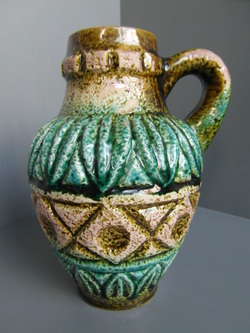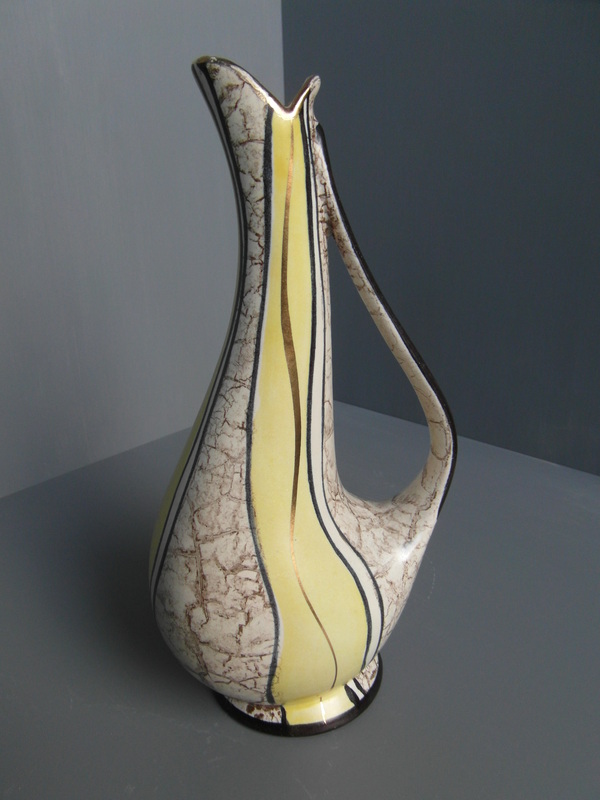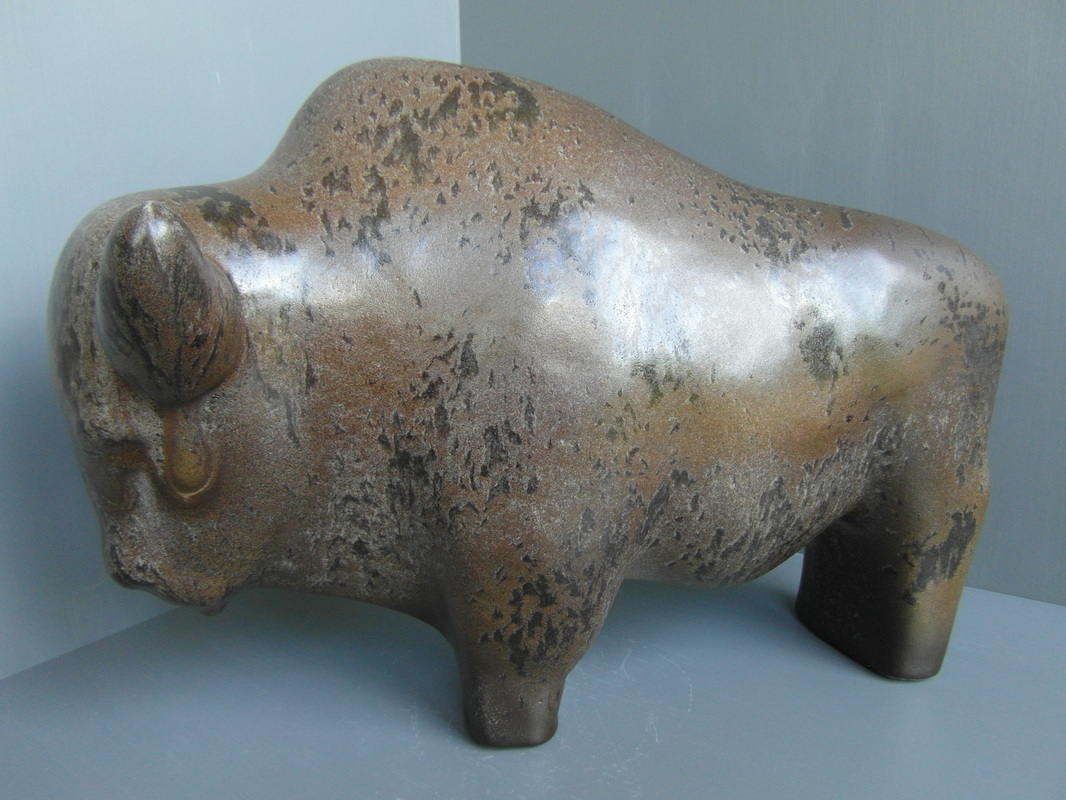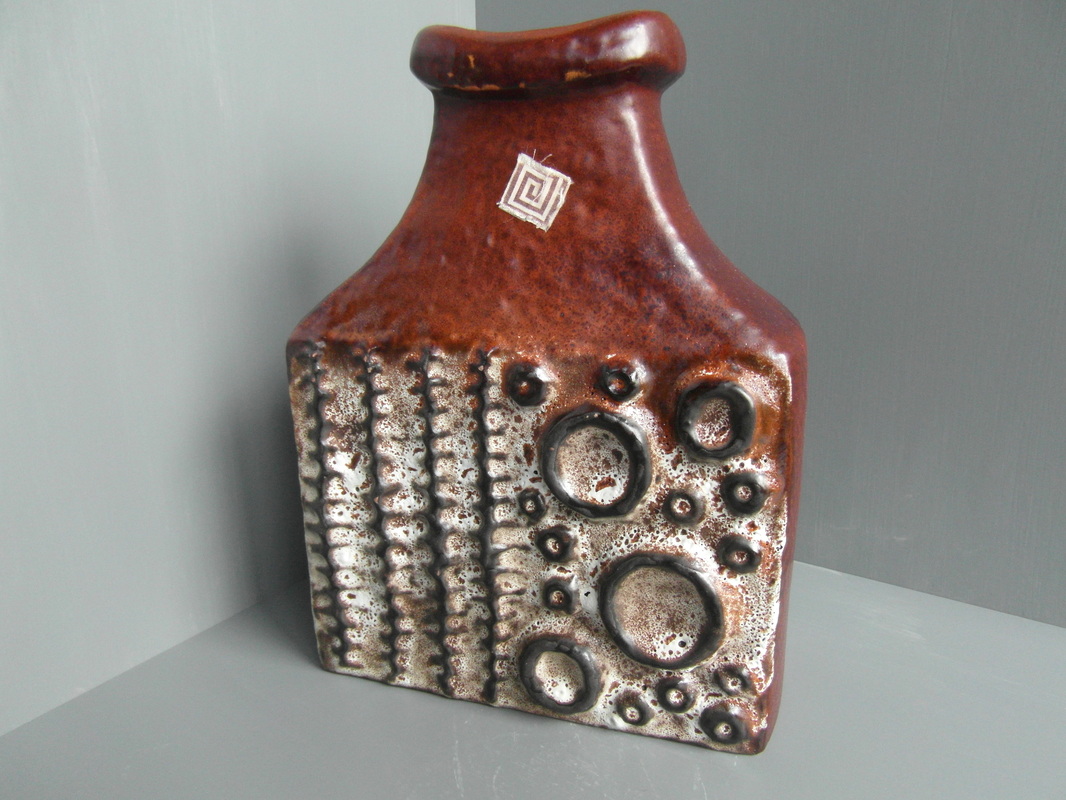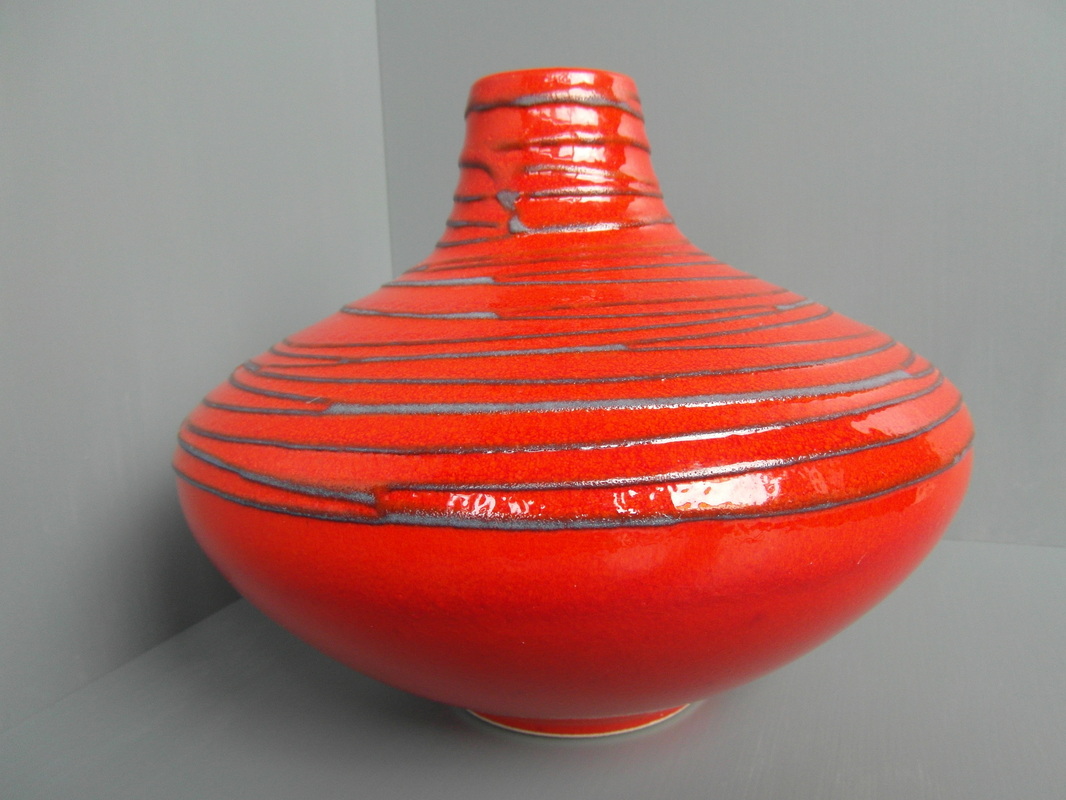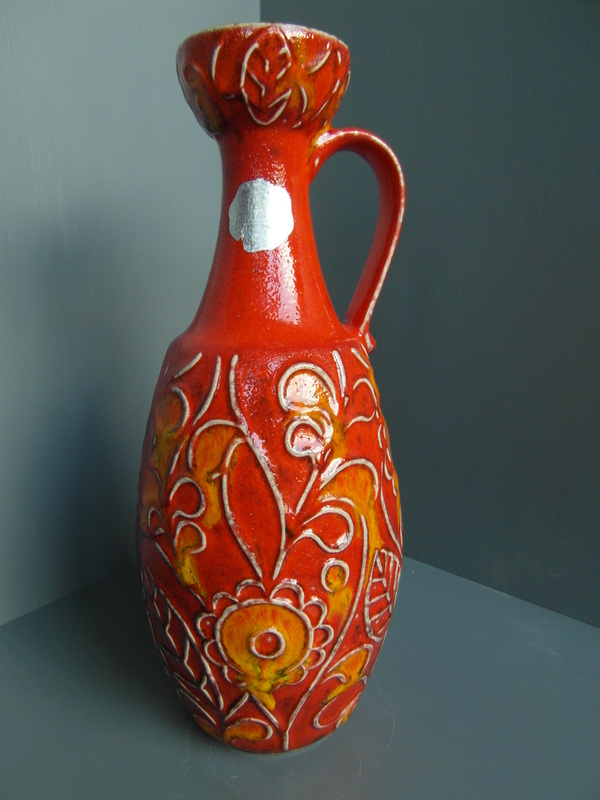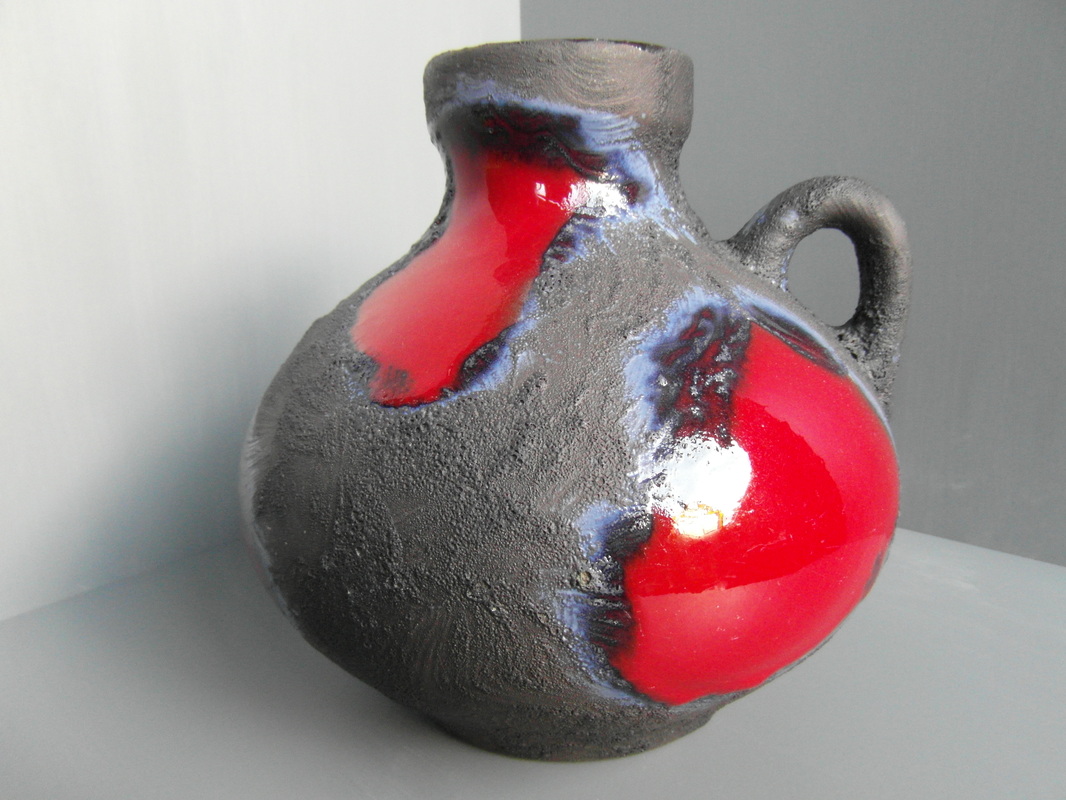Bezoek aan Wiesbaden / Visit to Wiesbaden.
Wiesbaden heeft mijn aandacht getrokken door een opmerking van James 'Lobo', een ander lid van het forum www.potteryandglass.forumandco.com. en zelf woonachtig in Wiesbaden. Nadat ik hem had gevraagd hoe het komt dat je op een rommelmarkt in zijn stad meer bijzondere vazen e.d. tegenkomt dan dat je ooit op een markt in Nederland zult aantreffen, was zijn antwoord:
Hello Angelo,
I am surprised by what I am able to find at the local fleamarkts here in Germany. But this area has been historically a wealthy area so maybe the people here were able to buy and decorate their homes more than
most families. As for exports to Holland after the war...I am sure that the exports to your country were fewer. There were restrictions and strong feelings against the German government, their products, etc....for good reason in those times. Those things are most likely the reasons I find so much here compared to the German pottery available in Holland.
Thank you and good luck with your collecting,
James.
In de jaren 6 tot 15 na Christus hadden de Romeinen in Wiesbaden een grenskasteel als militair ondersteuningspunt gebouwd. De centrale ligging en de aanwezige thermaalbronnen maakten het tot een aantrekkelijke plaats voor de bouw van een civiele nederzetting en het ontstaan van een badcultuur. De Romeinen gaven de legioensplaats de naam 'Aquae Mattiacorum' - de bronnen van de Mattiakers. De Mattiakers vormden een Duitse stam die in die tijd in de omgeving leefde. De naam 'Wisibada' werd pas voor het eerst vermeld in 828 na Christus. In de 14e eeuw was Wiesbaden voor korte tijd 'Reichsstadt'. De stad beleefde in de 19e eeuw een eerste opleving. In 1806 werd Wiesbaden de hoofdstad van het nieuwe hertogdom 'Nassau' en vanaf die tijd ontstond een systematische stadsopbouw die de basis vormde tot het ontstaan van een Wereldkuurstad. In de kuurplaats werden al snel de Europese adel en beroemde personen zoals Johann Wolfgang von Goethe, de Russische dichter Fjodor Dostojewski en Otto von Bismarck als gast ontvangen.
En nu liep ik daar op een zondagochtend van mijn hotel dat gelegen was in een klassiek deel van het centrum naar de plek waar de grote maandelijkse verzamelaarsmarkt moest zijn. Onderweg passeerde ik prachtige herenhuizen met iets te veel achterstallig onderhoud maar daarom niet minder mooi. Ik had me wat vergist in de afstand en ik vroeg aan een voorbijganger waar de markt gehouden werd. Deze man antwoordde dat het niet dit weekend was. Een tweede voorbijganger die ik de weg vroeg zei dat de markt er waarschijnlijk niet zou zijn omdat het vannacht geregend had, maar hij was ook op weg daar naar toe en ik liep achter hem aan.
Eindelijk kwam een grote parkeerplaats met daarop vele marktkramen in zicht. Al bij de eerste kraam ontdekte ik enkele kleine vaasjes van "Otto keramik". Die kom je in Nederland niet vaak tegen. Bij een volgend kraam kocht ik een vaasje van Bay voor 5 euro.
Hello Angelo,
I am surprised by what I am able to find at the local fleamarkts here in Germany. But this area has been historically a wealthy area so maybe the people here were able to buy and decorate their homes more than
most families. As for exports to Holland after the war...I am sure that the exports to your country were fewer. There were restrictions and strong feelings against the German government, their products, etc....for good reason in those times. Those things are most likely the reasons I find so much here compared to the German pottery available in Holland.
Thank you and good luck with your collecting,
James.
In de jaren 6 tot 15 na Christus hadden de Romeinen in Wiesbaden een grenskasteel als militair ondersteuningspunt gebouwd. De centrale ligging en de aanwezige thermaalbronnen maakten het tot een aantrekkelijke plaats voor de bouw van een civiele nederzetting en het ontstaan van een badcultuur. De Romeinen gaven de legioensplaats de naam 'Aquae Mattiacorum' - de bronnen van de Mattiakers. De Mattiakers vormden een Duitse stam die in die tijd in de omgeving leefde. De naam 'Wisibada' werd pas voor het eerst vermeld in 828 na Christus. In de 14e eeuw was Wiesbaden voor korte tijd 'Reichsstadt'. De stad beleefde in de 19e eeuw een eerste opleving. In 1806 werd Wiesbaden de hoofdstad van het nieuwe hertogdom 'Nassau' en vanaf die tijd ontstond een systematische stadsopbouw die de basis vormde tot het ontstaan van een Wereldkuurstad. In de kuurplaats werden al snel de Europese adel en beroemde personen zoals Johann Wolfgang von Goethe, de Russische dichter Fjodor Dostojewski en Otto von Bismarck als gast ontvangen.
En nu liep ik daar op een zondagochtend van mijn hotel dat gelegen was in een klassiek deel van het centrum naar de plek waar de grote maandelijkse verzamelaarsmarkt moest zijn. Onderweg passeerde ik prachtige herenhuizen met iets te veel achterstallig onderhoud maar daarom niet minder mooi. Ik had me wat vergist in de afstand en ik vroeg aan een voorbijganger waar de markt gehouden werd. Deze man antwoordde dat het niet dit weekend was. Een tweede voorbijganger die ik de weg vroeg zei dat de markt er waarschijnlijk niet zou zijn omdat het vannacht geregend had, maar hij was ook op weg daar naar toe en ik liep achter hem aan.
Eindelijk kwam een grote parkeerplaats met daarop vele marktkramen in zicht. Al bij de eerste kraam ontdekte ik enkele kleine vaasjes van "Otto keramik". Die kom je in Nederland niet vaak tegen. Bij een volgend kraam kocht ik een vaasje van Bay voor 5 euro.
Wiesbaden attracted my attention because of a remark by James Lobo, one of the other members of the forum www.pottery and glass.forumandco.com. He lives in Wiesbaden. After I asked him how come that one comes across so many more special vases in a Wiesbaden flea market than in any Dutch market, his reply was as follows:
Hello Angelo,
I am surprised by what I am able to find at the local fleamarkts here in Germany. But this area has been historically a wealthy area so maybe the people here were able to buy and decorate their homes more than
most families. As for exports to Holland after the war...I am sure that the exports to your country were fewer. There were restrictions and strong feelings against the German government, their products, etc....for good reason in those times. Those things are most likely the reasons I find so much here compared to the German pottery available in Holland.
Thank you and good luck with your collecting,
James.
In the years 6 to 15 A.D. the Romans had built a border castlet hat served as a military support point. Its central location and the thermal springs present there made it to an attractive site for the construction of a civil settlement and enabled the creation of a bathing culture. The Romans named the site of the legion ‘Aquae Mattiacorum’ – the springs of the ‘Mattiakers’. The ‘Mattiakers’ formed a German tribe who lived in the surroundings at that time. The name ‘Wisibada’was First mentioned in 828 A.D. In the 14th century Wiesbaden was a so-called ‘Reichsstadt’. The town revived in the 19th century for the first time.In 1806 it became the capital of the new duchy ‘Nassau’. From that time onwards the town maintained a systematic structure forming the base for the creation of a metropolitan spa city. In the spa famous people like the author Johann Wolfgang von Goethe, the Russian poet Fjodor Dostojewski, and the statesman Otto von Bismarck were honoured guests.
And presently it was me, walking there on a Sunny day from my hotel, situated in a classical part of the centre to the place where the collectors’ market was to be. On my way I passed several mansions with a little too much overdue maintenance, therefore no less beautiful. I was mistaken about the distance so it was that I asked a passer-by where the market was held. This person told me that it was not held that particular weekend. A second passer-by that I asked the way told me there would probably be no market as it had rained that night, but he was on his way to it as well so I followed him. Finally there was a large car park with a lot of market stalls in sight. Already at the First stall I discovered some small vases by ‘Otto Keramik’. In the Netherland we do not come across them too often. A the next stall I bought a vase by ‘Bay’ for 5 euros.
Hello Angelo,
I am surprised by what I am able to find at the local fleamarkts here in Germany. But this area has been historically a wealthy area so maybe the people here were able to buy and decorate their homes more than
most families. As for exports to Holland after the war...I am sure that the exports to your country were fewer. There were restrictions and strong feelings against the German government, their products, etc....for good reason in those times. Those things are most likely the reasons I find so much here compared to the German pottery available in Holland.
Thank you and good luck with your collecting,
James.
In the years 6 to 15 A.D. the Romans had built a border castlet hat served as a military support point. Its central location and the thermal springs present there made it to an attractive site for the construction of a civil settlement and enabled the creation of a bathing culture. The Romans named the site of the legion ‘Aquae Mattiacorum’ – the springs of the ‘Mattiakers’. The ‘Mattiakers’ formed a German tribe who lived in the surroundings at that time. The name ‘Wisibada’was First mentioned in 828 A.D. In the 14th century Wiesbaden was a so-called ‘Reichsstadt’. The town revived in the 19th century for the first time.In 1806 it became the capital of the new duchy ‘Nassau’. From that time onwards the town maintained a systematic structure forming the base for the creation of a metropolitan spa city. In the spa famous people like the author Johann Wolfgang von Goethe, the Russian poet Fjodor Dostojewski, and the statesman Otto von Bismarck were honoured guests.
And presently it was me, walking there on a Sunny day from my hotel, situated in a classical part of the centre to the place where the collectors’ market was to be. On my way I passed several mansions with a little too much overdue maintenance, therefore no less beautiful. I was mistaken about the distance so it was that I asked a passer-by where the market was held. This person told me that it was not held that particular weekend. A second passer-by that I asked the way told me there would probably be no market as it had rained that night, but he was on his way to it as well so I followed him. Finally there was a large car park with a lot of market stalls in sight. Already at the First stall I discovered some small vases by ‘Otto Keramik’. In the Netherland we do not come across them too often. A the next stall I bought a vase by ‘Bay’ for 5 euros.
Bij weer een volgende kraam kocht ik een wat ouder bijzonder vaasje van Bay.
At another stall I bought a somewhat older special vase from Bay.
At another stall I bought a somewhat older special vase from Bay.
Even later merkte ik dat er veel handelaars aanwezig waren. Dus alles wat ik hierna zou tegen komen zou waarschijnlijk niet representatief zijn voor het aanbod van west germany vazen in deze streek. Zo kwam ik in contact met een 'verzamelaar' die mij een aanbod deed voor een prachtige dierfiguur, een stier, van Ruscha en hij deed me aanbod voor nog twee andere waar ik tot mijn spijt niet op in ben gegaan.
A little later I noticed there were a lot of traders present, so everything I would meet after this would probably not be representative for the range of ‘West Germany’ vases in this region. This is how I met a ‘collector’who offered me a splendid animal figure, a bull by Ruscha and who also made me an offer for two other specimen that I did not accept regretfully, I must say.
A little later I noticed there were a lot of traders present, so everything I would meet after this would probably not be representative for the range of ‘West Germany’ vases in this region. This is how I met a ‘collector’who offered me a splendid animal figure, a bull by Ruscha and who also made me an offer for two other specimen that I did not accept regretfully, I must say.
En daarna nog deze van Carstens(foto onder) / after that this vase from Carstens(picture below)
en deze van Fohr(foto onder) / and this vase from Fohr(picture below)
en deze van Bay(foto onder) / and this vase from Bay(picture below)
en deze van Marei(foto onder) / and this vase from Marei(picture below)
Al met al toch een mooie gevariëerde collectie maar op de juiste markten kan je deze vazen ook in Nederland wel tegen komen.
All in all a nice varied collection, but in the right markets you can also find these vases in the Netherlands.
All in all a nice varied collection, but in the right markets you can also find these vases in the Netherlands.
Panorama van Wiesbaden gezien vanaf de Neroberg.
Panorama of Wiesbaden seen from the ‘Neroberg’ (Mountain Nero).
Panorama of Wiesbaden seen from the ‘Neroberg’ (Mountain Nero).
